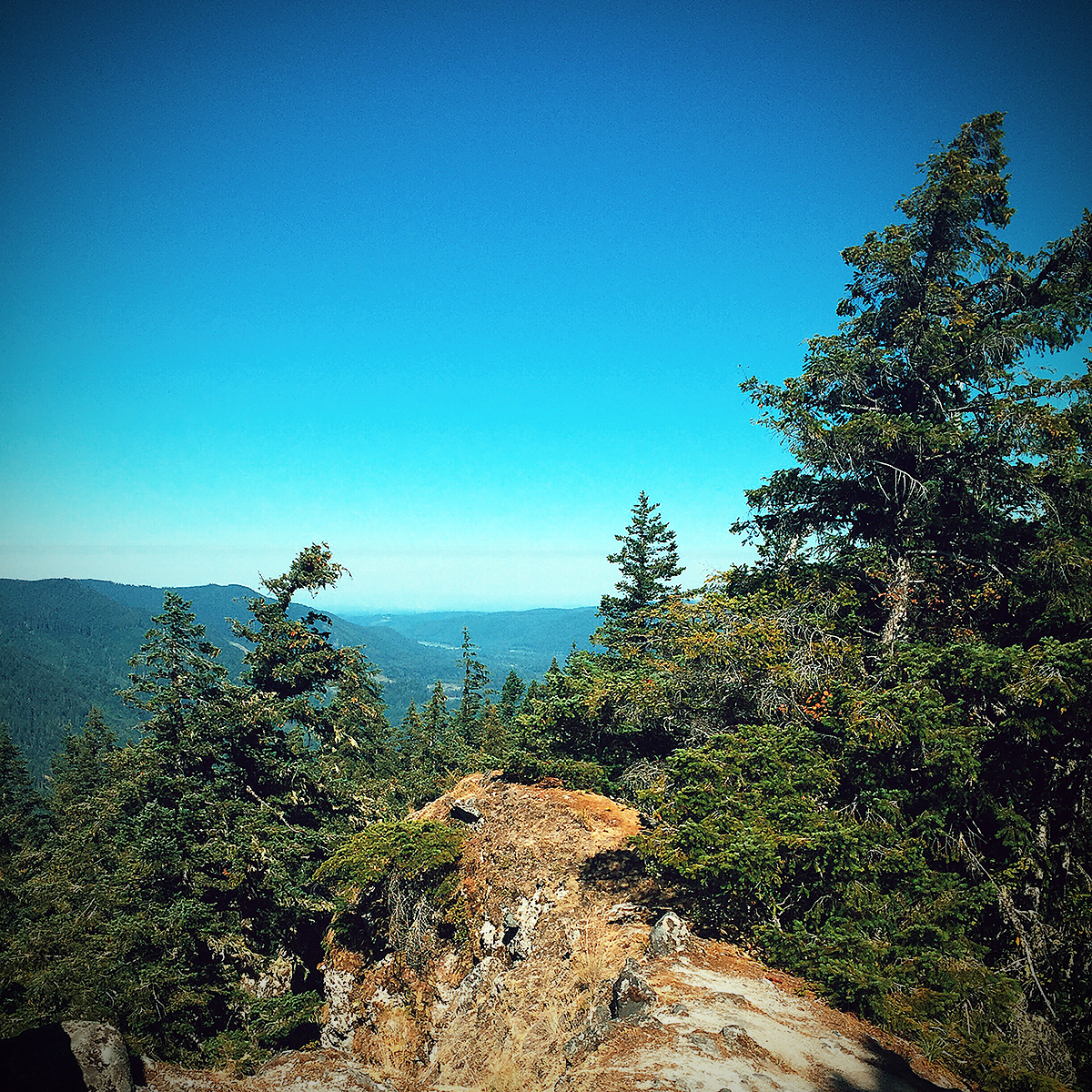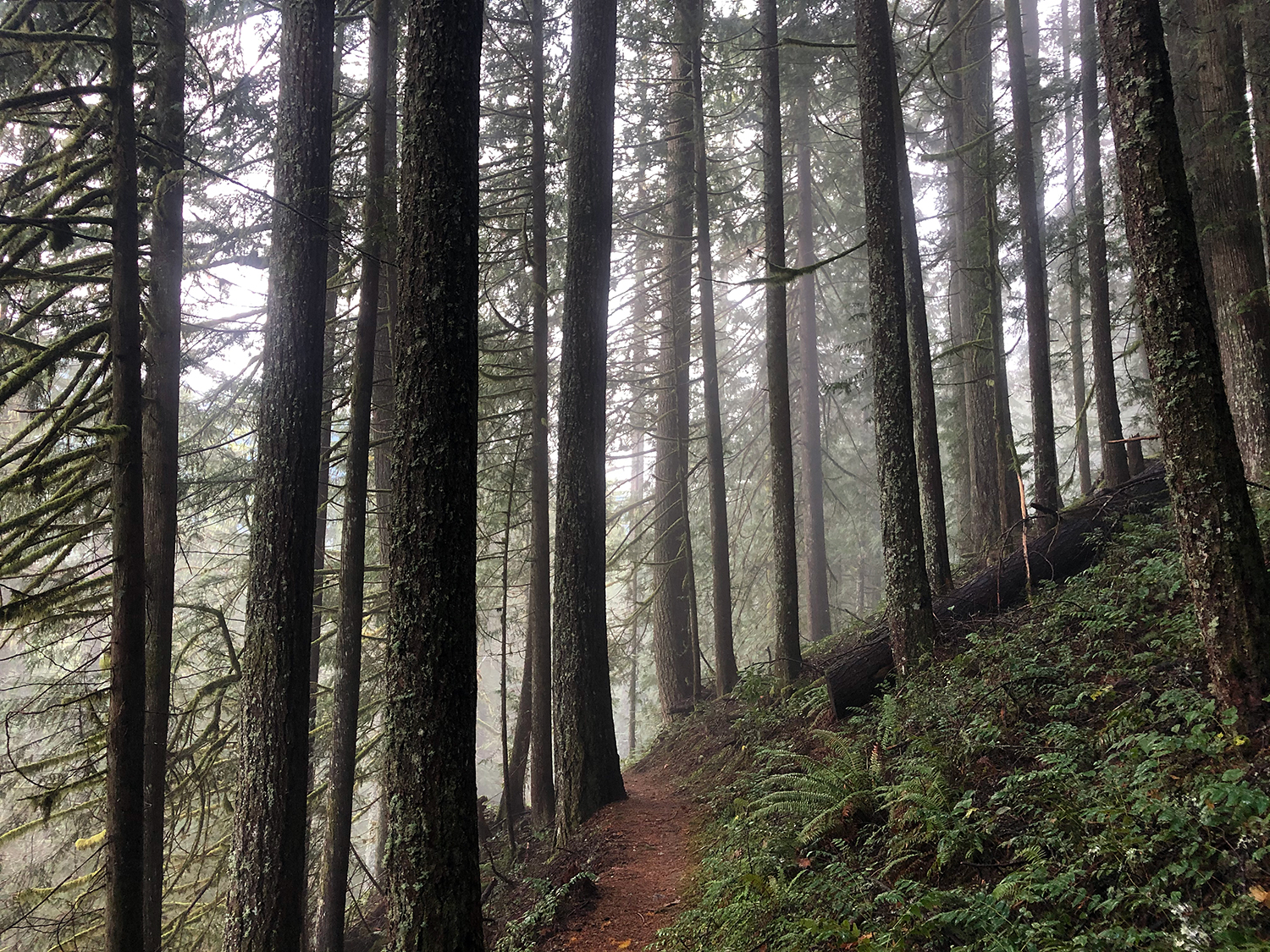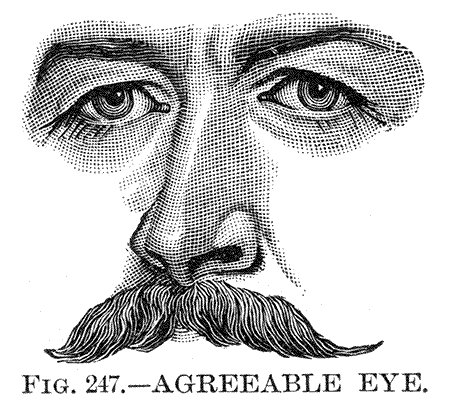November 2020
a singular philosophy
13 November 2020, around 7.00.

The view from the ridge,
circa late summer 2017.
The path that I like to walk (and have for some years) is the beginning of a nine-mile trail that goes up to a Forest Service lookout (which I have not yet reached, and probably never will, by that route). The trail climbs a series of rapid switchbacks before descending briefly through a slight depression and rising again in more languorous, arduous switchbacks to an initial eminence where one feels on more equal footing with the trees and the ground is covered with dark glossy leaves, perhaps ivy, but more likely Oregon grape or salal. The trail continues along the ridge to a viewpoint where one can at last see clear through across the valleys to the next line of foothills.
The first time I reached this viewpoint, which one approaches by a short blind scramble, I thought someone had left a large glossy black trash bag on the trail, rustling slightly in the wind. As I came closer, though, it resolved itself into a turkey vulture, which peered at me briefly before hopping awkwardly and flying away. It swooped around a few times, then disappeared behind an outcropping. This viewpoint was also, I believe, the spot where a far-ranging mountain lion attacked and killed a holiday weekend hiker, whose backpack was found later that day. The trail was closed for several weeks as search and rescue teams scoured the slopes, and when it reopened it was marked by the hoofprints of mules, which are the only convenient way to move anything heavy along the trail.
Everything, in this world of work, leisure, activity, reproduction and consumption of things, everything has its function, its place, its utility, and a specific word that corresponds to it. Likewise our grammar reproduces our sequencings of action, our laborious grasp of things, our fuss and bustle. Always doing, producing, forever busying ourselves. Our language is tailored to the conventions of fabricated things, predictable gestures, normalized behaviours, received attitudes. Artifices adapted to one another: language is caught in the everyday construction of the world, participates in it, belongs to the same order of things as pictures and numbers and lists – order, injunction, synthesis, decision, report, code. Language is an instruction slip, a price list.
There are several problems with A Philosophy of Walking. It was intended for a popular audience, and one is tempted to agree with the somewhat derisive observation of Gros’s (unspecified) colleagues who ‘would [not] consider this a serious academic book’ – but not, as Gros imagines them saying, because it is ‘too transparent’ (if by transparent one means clear, coherent, comprehensible), but because it is insufficiently so. A Philosophy of Walking is broken up into short chapters that fall into three types: personal ruminations on walking as practice, light marketing copy for key types of walking (i.e., backpacking, pilgrimage), and précis of literary or philosophical figures who either wrote something about walking or for whom walking formed a significant biographical element (e.g., Kant, Nérval, Nietzsche, Rimbaud, Rousseau). 1
This structure allows latitude for a wide-ranging ramble, but sadly falls into the narrow but already populous meridian of Thoreauvian solipsism that assumes clean laundry but no laundresses (or laundromats). It is a book – despite its topic – that remains saturated with the aroma of libraries and notecards, and it does not sufficiently distinguish between the act of walking and the process of moving from point A to point B. These are two of the broader problems of the book, but there are more specific problems that intrude upon one’s enjoyment: the lack of danger, 2 the lack of women, 3 and the dismissal of urban walking, 4 which ultimately may all be connected to the erasure (or perhaps rather an elision) of time and (more importantly) change. In Gros’s philosophy, every solitary walker ought to aspire to the focus of the long-gom-pa and step apart from time. 5 If nature is encountered, it is wholly external, separate – a view, a difficulty overcome, an accessory to the greater fact of walking.
I would perhaps not have noticed this if the chapter on slowness had not reminded me so powerfully of Nan Shepherd’s The Living Mountain, which Gros does not mention or appear to know. 6 Shepherd’s book is a memoir of her many years walking the Cairngorms in all weathers and moods; this is a feeble description, but what Shepherd captures so magnificently is the way that, even following the same paths, one is always going somewhere new. There is always a sense that the human body is part of nature, is subject to nature, despite crofts and huts erected against the elements. Although scorning the man-made environment, Gros remains tethered to the CV, to the appointment book, to Thoreau’s shack, to Heidegger’s Hütte, to the grocery-store mentality that ripens wild strawberries and bilberries at the same time (191) – and there is a lingering sense that a walk could only be valued by the pilgrim’s badge it yields, even if that badge is the mere fact of walking. 7 I am not being wholly fair, but these are the things that my memory was willing to unearth; these are the things I carry with me on my own walks.
On the path to a road lined with vacation cabins only occupied on weekends by folks driving cars with out-of-state plates, there is an uncanny assemblage of twigs and moss that looks like an old fellow sat on a porch, raising a glass to toast a new arrival. It very much appears to be a made object, twigs and bearding moss arranged to form the appearance of flesh set back on a rough chair of branches and vines. This effect is enhanced by a desire path running at its feet and a bright orange ladder tilted some ten or fifteen yards behind it. A closer inspection reveals, however, that it is fundamentally a natural artifact, an unfortunate stunted conifer sapling that did not survive some previous winter and has gathered moss on its westward branches, while the eastward branches were discouraged by wind or broken off at some earlier date. From the corner of the eye, though, it still appears to be a forked creature raising an arm in camaraderie, ready to tell a tale to unwary passers-by.
- One can set aside, for the moment, the arrogance of summarizing Nietzsche or Rousseau on walking, as both writers have more charm and/or character than most.[↩]
- He does not mention, for instance, that it was on one Rousseau’s solitary walks that the philosopher was struck down by a large dog (and narrowly missed by a carriage), hitting his head against the pavement and suffering a concussion and probable neurological damage that may have hastened the stroke which led to his death; see Walk 2 in Reveries of a Solitary Walker for Rousseau’s account of the incident.[↩]
- I was somewhat surprised that the review by Lauren Elkin, author of a book about women and walking, did not mention this omission.[↩]
- The chapters on strolling and the urban flâneur are given with a somewhat jaded sigh as something obligatory rather than interesting.[↩]
- Or clock time; there are several different senses of time considered, but so lightly that their strands remain somewhat tangled and I am in no humor to untease them.[↩]
- The absence of Shepherd where she would have been relevant and added depth drew my attention to other absences in the book – women rare and only as observers of men, no mention of people outside the white Christian fold as individuals (with the exception of Gandhi). Although I had been favorable disposed towards the book to begin with, these omissions chivvied me from the vestibule of admiration into the dim passageway of disapprobation.[↩]
- Bilberries (myrtille, i.e., Vaccinium myrtillus L. or one of its relatives) begin to ripen August–September; strawberries generally begin to ripen April–June, depending on variety – they can of course appear through November, depending on the weather. I am perhaps being overly skeptical (and perhaps thinking of Oregon’s wild strawberries and huckleberries [V. deliciosum, though it seems silly to call a North American plant by a Latin name], which one would have to be fortunate indeed to find in an edible state on the same trip). I suppose if one has left one’s rucksack up a tree out of some peculiar desire to feel free (from what is not quite clear), then even late strawberries would seem sweet.[↩]
on being seen
19 November 2020, around 5.31.

Tu n’as rien vu à Hiroshima. Rien. // J’ai tout vu. Tout.
Quite so! You have not observed. And yet you have seen. That is just my point. Now, I know that there are seventeen steps, because I have both seen and observed.
Had Marguerite Duras written nothing other than The Lover, it could be considered a book of great nuance and depth, full of thought-provoking reflections on human relationships, morality, and adolescence and the murky half-lights of colonialism, sexualities, and phenomenology. Duras has, however, written other books, and they are so much of a muchness with The Lover that the book itself becomes nearly indistinguishable from the aura of the writer. 1 In trying to make sense of my own reaction as a reader, this tangle between opus and oeuvre does not, in this case, increase my sympathy; as I have mentioned earlier, Duras is not a writer I particularly admire. Why did I read The Lover, then? It was loaned to me two years ago and I wanted to return the book; it was briefly analyzed in Meander, Spiral, Explode in such a way as to make me wonder if my impatience with the author was perhaps a sign of my laziness as a reader; it was short.
What I want to seem I do seem, beautiful too if that’s what people want me to be. . . . I can become anything anyone wants me to be. And believe it. Believe I’m charming too. And when I believe it, and it becomes true for anyone seeing me who wants me to be according to his taste, I know that too.
There is much to dislike in the book: the relationship with between the fifteen-year-old narrator and the twenty-seven-year-old parasitic son of a wealthy man; 2 the narrator’s unpleasant family; the narrator’s half-lustful, half-loathing descriptions of her classmate; the way none of the characters seem to connect, but ping against each other while remaining apparently whole, intact, entire. Of course so much of small talk is just a sticking plaster to cover over the wounds of human contact, but the entire novel has the feeling of a confessional gush, as of a traveller talking to a stranger on a train or a boat or plane because there is no one else to talk to and the need to confess, or to express, is so urgent. This is a wound that requires stitches, though. 3
A very beautiful woman who looks at her reflection in the mirror can very well believe that she is that. An ugly woman knows that she is not that.
In trying to describe The Lover, I would say, half-jokingly, that it is oversexed and underbred, because this is the sort of narrow-minded priggishness that might characterize a superficial reading of the novel. I felt somewhat guilty about this reaction, as it didn’t seem fair to judge to the novel in these terms. A look through the footnotes of The North China Lover – the more fully fleshed out version of the story, intended as a guide for a film version – indicates that this was, in fact, the effect intended: the narrator should have ‘an untamed curiosity, a lack of breeding, a lack, yes, of reticence’ (p. 61, note). Yet what is not said, what is left to the imagination, is so much of what makes the book tantalizing and (potentially) erotic that to have this confirmation that the book is to be judged so lightly, on its surfaces, on its superficialities, is disheartening. 4 The Lover, then, is and only ever could be part of the cult of Duras, which focuses on the anxiety of desirability, of power wielded not through will or choice but through being. I am in the habit of finding this sort of sentimental nihilism unhelpful in my daily life and think it rather tedious when encountered in books – and The Lover, given the company in which it must be considered, is not an exception. 5
- As with Tom Clancy or Danielle Steele – or indeed, Henry Miller or Anaïs Nin – the appeal of Duras is the brand of the author as much as the character of the books (if not more so).[↩]
- The presentation of the lover as weak, ‘a helpless pray to insult, vulnerable’, ‘nothing masculine about him but his sex’ (38) – and even that, by the end, as impotent as the rest of him (109) – does not significantly vary from the weak-willed rakes and rattles of his Parisian models – he is not presented as desirable in himself, but only after the narrator notices ‘the smell of gold’ (42). This made the introduction’s emphasis on the ‘sexiness’ of the lover somewhat odd.[↩]
- The notion, presented towards the end of the book, that there was genuine sentiment between the pair – the sort of long-term, star-crossed love that might have ended differently if he had been able to stand up to his father and she had not felt she needed to support, in some way, her mentally unbalanced mother and wastrel brother – rang false. It is possible, I suppose, that if either character had been more – or less – selfish, they could have made a conventional novel of it. Yet when he phoned her up years later and told her ‘that he still loved her, he could never stop loving her, that he’d love her until death’ – this seemed like more weak-willed, self-indulgent pandering to the narcissism of the narrator, as though after so many years or so neither the narrator nor the lover has essentially changed. If one carries a torch for that long, it seems unlikely that anything of the original fervent devotion or lust remains, but rather that one has fallen into the habit of carrying torches. There is nothing wrong with this – everyone has their hobbies.[↩]
- Indeed, this realization is what I imagine it would feel like to bite into the fruit of the tree of knowledge expecting a crisp apple and finding it to be an overripe mango.[↩]
- I am willing to admit that if it had been the first of Duras’s books that I had read, I would have liked it more – and would perhaps be more interested in her as an author. Alas, I did not know and now, knowing, I cannot change the past.[↩]
new frontiers
23 November 2020, around 11.06.
It was around the time I was reading the first or second of a series of translations of Beowulf and I mentioned it in passing in an email. My correspondent replied that they thought they should probably read more fiction, but it was hard to find the time. This response surprised, not because I thought my correspondent had more time, but because I had not thought of Beowulf as fiction. It is poetry, which seems to me a category of writing so tenuously connected with the idea of fact that it feels odd to think of it in terms of fiction or non-fiction at all: it is simply poetry – a made thing in which there is more or less truth as the making of the thing requires.
This sprang to mind because I happened to be reading J.B. Rhine’s New Frontiers of the Mind about the experiments of the parapsychology lab at Duke (1930–1965), and encountered a similar type of ambiguity in terms of fact and fiction. Psychical research and the paranormal are not of particular interest to me, but I find the scientific apparatus that built up around them somewhat more intriguing – in much the same way I find any history of any intellectual process diverting. Indeed, I only began to grasp that sincere psychical research was a ‘thing’ (as opposed to something completely made up for Ghostbusters or plain quackery) when browsing through the amusing and earnest volume of William James’s Essays in Psychical Research.
So I’ve found myself – I’m not wholly certain how – reading New Frontiers of the Mind and trying to shape my opinion about it. What I noticed (and what spurred this attempt to articulate anything on the matter) was that I could not read the book with the type of attention I would give to a work of scholarship or non-fiction for a general audience, but rather was forced – by its tone, by its subject matter – into a regard between what I would give to something I recognized as truth (including the truths expressed by fiction or poetry) and something wholly made up. Rhine’s descriptions of the experiments felt more like lengthy and not particularly imaginative attempts at world building rather than activities involving research subjects with names and identities (of course carefully sealed to ensure privacy). It left an impression similar to the use of religion in politics; to argue that the interpretation of a text or phenomenon is dubious is to accept the premise that it is worth considering in that particular context in the first place – and where there is room for credulity, there is still room to doubt.
A view (51)
26 November 2020, around 9.46.

